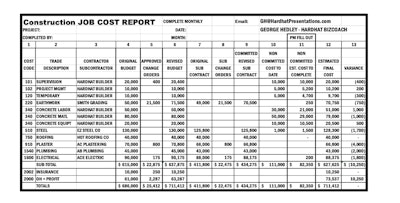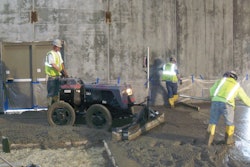
Would you enjoy watching a professional golf tournament if the players didn’t keep score? Or could you be a great football coach if you didn’t know the score or player statistics during the game? Or could you help baseball players become better hitters if you didn’t know their batting averages or how well they hit the ball?
Of course not. Then how can you run a construction project efficiently and professionally manage it without a scorecard clearly displaying your updated job costs? Running construction jobs without knowing your job costs is like driving blindfolded in a NASCAR race. You’ll surely crash and not like the outcome!
Most smaller contractors don’t keep an accurate and timely updated accounting of their project budgets and job costs until it’s too late. And they also don’t know how well they do until they’re finished with the project and all the bills are paid. And to make matters worse, many contractors never know how well each job does and continue to bid work with bad numbers and bid rates.
Plus field foremen and superintendents also don’t have a clue if they need to work faster or more efficient to bring their jobs in on budget. And finally at the end of the year, the company accountant informs the owner how well the company did or didn’t do. This is much too late to make an adjustment. Driving blind is not a great way to manage a company or a project.
When halftime comes in sporting events, winning coaches look at the scoreboard, player statistics and their strategy to determine what game plan adjustments are needed to win the game. Without knowing the score, coaches can only guess what might work during the next half to do better or improve.
Good information is what business owners and managers use to make decisions. Good information equals good decisions. No information equals bad decisions relying on luck. When you don’t know where you are, you don’t know what you have to do to get where you want to go. If you know where your job costs are at the half way point in a project, you can then make intelligent decisions and strategic adjustments to get back on track.
Read next: What Your Overhead Mark-Up Should Include
Maintain updated job cost reports
Set up your construction job cost tracking system by using a spreadsheet similar to the example shown here. Set it up with the following columns to track your budget versus actual costs:
- Cost Code
- Trade Description
- Contractor / Subcontractor / Supplier
- Original Budget
- Approved Change Orders
- Revised Budget
- Original Subcontract
- Subcontractor Change Orders
- Committed Revised Subcontract
- Non-Committed Cost To Date
- Non-Committed Estimated Costs To Complete
- Estimated Final Costs
- Variance
 Sample job cost report.George Hedley
Sample job cost report.George Hedley
Keeping accurate and updated job costs on construction projects starts with analyzing your bid estimate and then establishing a realistic project budget. Use your bid estimate summary to create the original job budget in column 4. Then as you build and move forward, keep track of any approved change orders in column 5 and the revised project budget in column 6.
Your subcontracts and purchase orders are firm committed costs in columns 7, 8 and 9 and shouldn’t vary as you’ll be spending all of the approved amounts for these trades. Therefore, you don’t have to keep track of the costs to date for these committed items.
However, the non-committed items you perform or construct on a cost plus basis including labor, equipment and materials on self-performed work items need to be tracked as you spend the money in column 10. At the month end, the project manager now needs to estimate how much additional money for labor, materials and equipment will be required to complete the project.
Enter your estimated cost to complete in column 11. Next total the final cost in column 12 and calculate your variance for each line item and total in column 13 to determine if you are over or under budget at that place in time.
Read next: How to Allocate Overhead to Projects
Technology speeds time for job costing
As a professional construction business coach, I am amazed at the number of companies that don’t track their jobs costs on a regular weekly or at least monthly basis and then share them with their crews. I can’t understand why owners and managers work so hard without knowing the score. People who don’t know what results are required to meet their goals, or how well they’re doing, have no reason to go faster or work harder.

Before computers, I would take a few days every month to add up all the costs committed and spent for each line item on every project I had under construction. Then I would meet with the project field foremen or superintendents to discuss and determine the estimated costs to complete each project.
By doing this task every month, I knew exactly how well each project was doing, my field team leaders stayed focused on hitting expected results, we always had a handle on what it would take to finish on-time and under budget, and we could make the necessary adjustments to make more money.
Now with the use of simple spreadsheets, computers, fully integrated software accounting programs, and easily available professional construction bookkeepers, the monthly job cost update exercise only takes 10 to 20 minutes per project to complete, update and review.
There’s no excuse not to know the score on every job now, except being lazy, not caring or not making knowing your numbers a priority. To make more money on every project, dedicate the time required to sit down and complete a ‘Job Cost Report’ for every project under construction at least every month.
Read next: Margins, Mark-Up & Making Money!




















